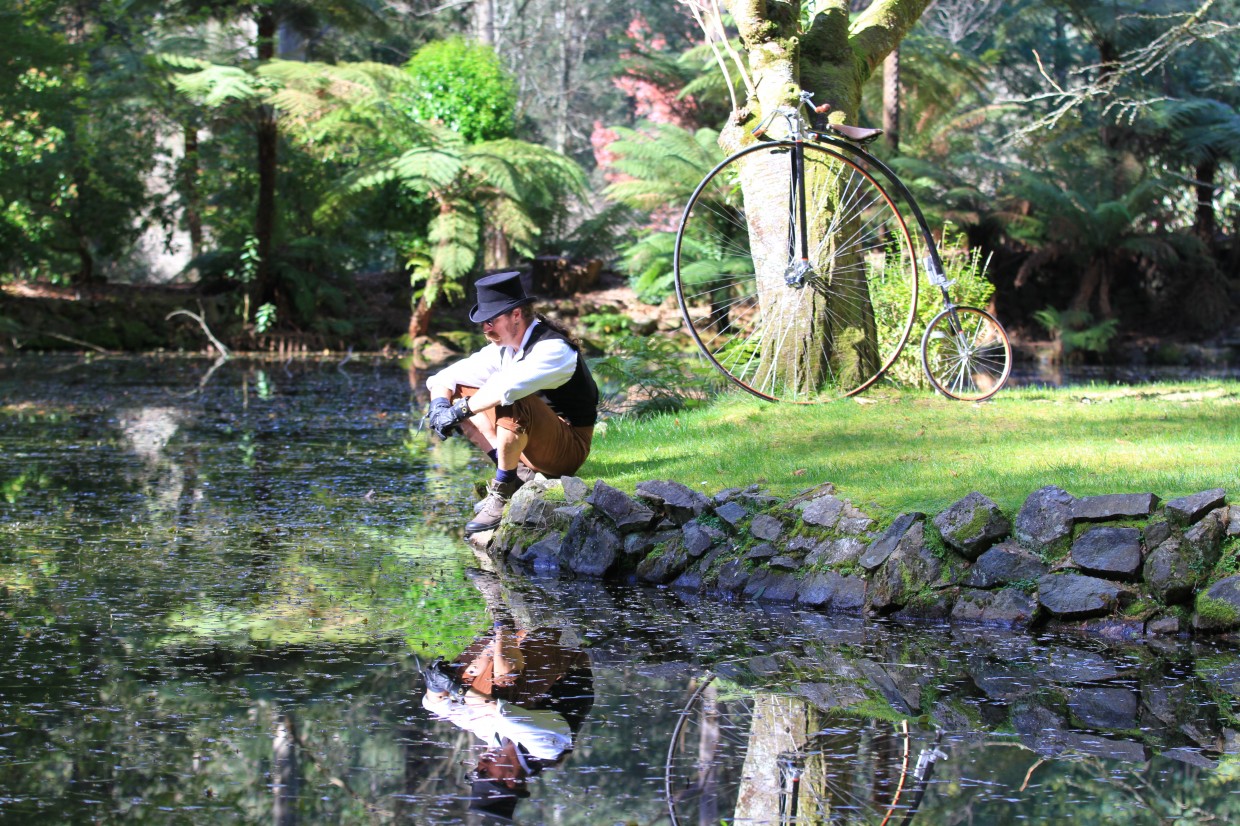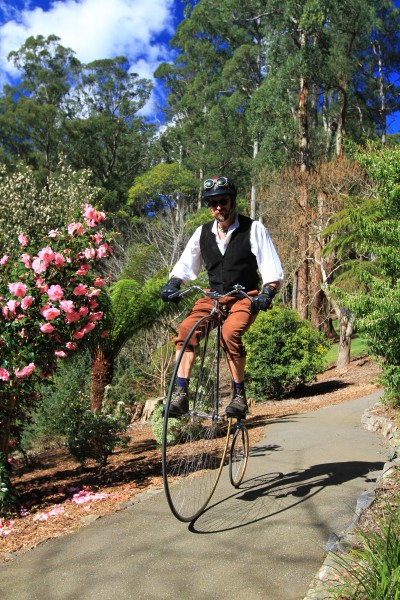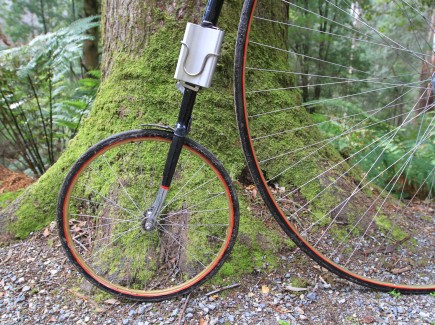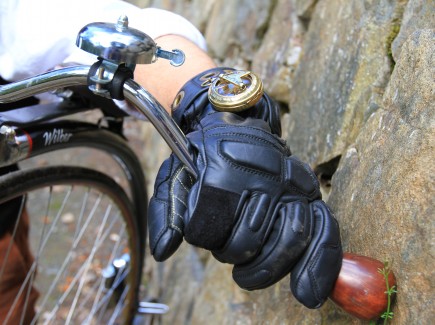Euan Pennington steps back in time to explore the pleasure and pitfalls of penny farthings.

All photos: Iain Groves
I have had some unique riding experiences recently. A Commodore with P plates slowed down and gave me a wide berth and a wave. P plates. Commodore. I kid you not. A semi-trailer pulled over to let me through a narrow street. People constantly wave and take photos, even give me right of way when it’s not legally mine to have, yet I am not a movie star. To a commuting urban cyclist, this must sound like a chain-sniffing-inspired dream of utopia. After all, people are not mounting cameras on their bikes these days because they treasure the ride to work. It can be rough out there. So what is going on?
It’s all about the bike. I have taken to riding a Penny Farthing, and the reactions are… interesting. Unpredictable. Amusing. Penny Farthings appeared in the late 1860s, as the young men of the world, in a bid to go faster (and let’s face it, to look jaunty), enlarged the drive wheels of their bikes. Pedals in those days were attached to the front axles, and gears did not exist, so it was the only way to create mechanical advantage. Penny Farthing is actually a retronym; originally they were just known as ‘bikes’. Now, in Australia, they are simply ‘Pennys’. In America they are ‘Highwheelers’, and in Britain they are called ‘Ordinaries’.
The style of bike lasted around 20 years, from the late 1860s until the 1880s, when some young upstart invented a bike with a diamond shaped frame, a chain, brakes, and a seat from which you could reach the ground. Who’d have thought that would catch on? These were called ‘safety bicycles’, leaving the larger wheeled companion to be dubbed ‘ordinary’. “Do you have one of those new safety bicycles?” “No, I have an ordinary one.”
Safety bicycles were designed to address a few small issues that the Pennys have. There are no effective brakes (the brakes on the back wheel are largely ineffective and brakes on the front wheel can send you over the bars). There are no gears. When riding, your head is some eight feet (2.44 metres) from the ground—ground you can’t reach with your feet. The riding position is such that all your weight is above the front axle, so that should the front wheel stop for any reason, as a rider you generally won’t. The term “header” was coined by Penny riders, because so many landed on their head, to the grave detriment of their health.
Which somewhat begs the question, why ride a Penny? In short, it’s not a question that can be easily answered in words; you just have to try one. They are fun, and relaxing, you see the world from a different perspective, they are a challenge and every ride is an adventure. Not entirely practical, but joyous. They are simple, and there is a marvelous heritage. You can even dress up to go riding, and not in lycra. For gents, moustache wax is practically mandatory. For the cycle tragic, they are irresistible.

Should you want one, there are perhaps half a dozen workshops in the world making them full-time. All the others are made by clever and talented people in sheds, so you will need to find one of those people, or look at the second-hand market.
I first rode one at a fringe festival, and it was love at first sight. Months of research, interweb browsing and general sniffing followed until I found the one pictured. They are not something one often sees for sale, and prices can reflect this. Rough ones are well over $1,000, and you can expect to pay between $2,000–$4,000 for something smart. In addition, you will need to cunningly purchase the right size. Front wheels vary in size in respect to the rider’s leg length. Some have variable length cranks, but seats are not adjustable, so the right sized bike is crucial in being able to reach the pedals, and not jamming your legs up under the bars. The most common sizes are between 48 and 52 inches (122–132 cm), in terms of front wheel diameter.

For those who are curious, the one pictured is a 52 inch, and 18 years old, with the front forks cut from a VW driveshaft, and the headset from the gearbox. Obviously mine was designed and built by one of those clever people in a shed. Interestingly, the front rim is a Velocity road rim, just made bigger. You ring up and ask for one, they kindly send it out, and you drill the 62 spoke holes yourself—carefully, with steady hands and solid measuring skills. Of course, you can buy an original Penny from the 1880s for $7,000 and upwards, but do you really want to rely on 120 year old spokes? Good for parades, but perhaps not everyday machines.
Once you have your bike, it’s just a case of careful practice, perhaps some input from an experienced rider to begin with, and mapping routes with minimal hills. Like some buses, boarding is done via the rear step, once you have punted the bike along to gain momentum. From there you take a seat, find the pedals and you are away. You can’t really stand up on the pedals, so all activity is done seated, and of course the pedals are fixed, so no stopping to coast. Steering is unusual, because the bars move as you pedal, and when cornering sharply the wheel can, indeed does, graze your inner thigh (and not always in an enticing fashion), so care needs to be taken that nothing important gets in the way. Fine adjustment in the personal region is actually more important than you think, given you can’t stand up on the pedals over the bumps. It is, however, very stable at low speed, and, oddly enough, a bit scary at high speed.
As yet, I have not stepped off the bike in a catastrophic fashion, but I have met people who have. I did have the handlebar fracture off in my hand, which was disappointing as it’s a critical part of the dismounting process, so that resulted in a sprightly leap/fall/roll sideways. Luckily, there was no harm done. Overwhelmingly though, my riding experiences have been positive. I have fun and the bike seems to make everyone else around magically happy. People wave, shout out, laugh, ask endless questions and are generally fascinated. It’s not uncommon to be passed by a car with someone leaning out the window taking photos on their phone.

Owning a Penny is akin to having your own personal time machine. With practice, you may find yourself in Evandale, Tasmania, for the largest annual gathering of Pennys worldwide. It’s like a bike race, but with style and moustaches. The possibilities are endless. The first circumnavigation of the world by bike was on a Penny, and a chap named Joff Summerfield is currently circumnavigating the world on his even as we speak, for the second time. Back in the 1880s the Melbourne cycle clubs used to meet on the weekend for a quiet ride to Frankston and back, but you could not participate unless you were skilled enough to mount without the use of the back step. Fiddlesticks to those tiresome less skilled riders. Naturally they had team uniforms and caps, which all sounds familiar…especially to those roadies who now make the trip!
Whilst they look intimidating, I would suggest Pennys are “different”, rather than “harder” to ride, so if you are a keen cyclist and do get the opportunity to try one, don’t hesitate to climb aboard. Just make sure you have plenty of room in the shed before you do, and room in the budget for some suitably jaunty cycle clothing.
Ride On content is editorially independent, but is supported financially by members of Bicycle Network. If you enjoy our articles and want to support the future publication of high-quality content, please consider helping out by becoming a member.

You, Sir, are indeed a true inspiration…a living, breathing, riding, gentlemanly Ode to that which we have now forgotten: the sheer pleasure of a Ride. Indeed, there is nothing “Ordinary” about this article.
Well done to you, and I sincerely wish you come to no harm whilst indulging in your pastime!